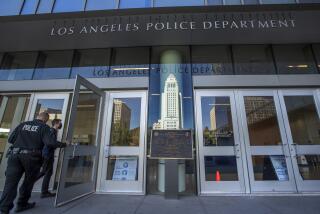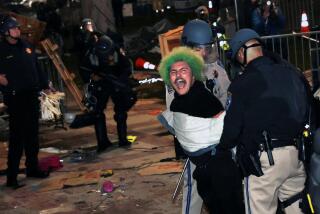Officers who fired projectiles at protesters violated LAPD policies, panel rules
- Share via
Los Angeles police officers broke department policy when they shot one protester in the head with a projectile and another in the testicles during mass protests last spring, the civilian Police Commission ruled Tuesday.
In the first case, in which CJ Montano was shot in the head as he held his hands in the air during a protest in the Fairfax district on May 30, the commission agreed with LAPD Chief Michel Moore and an internal department review board that the officer broke policy.
Moore concluded that Montano, who was about 55 feet from the officer, did not pose an immediate threat. Similarly, the chief found that a group of protesters farther away who the officer claimed to be targeting were also not a threat.
In the second case, in which Ben Montemayor was shot in the groin in Hollywood on June 2, the commission broke with Moore and a review board in finding the shooting violated policy. Moore had concluded that Montemayor was a potential threat and that the shooting was justified.
Montano was hospitalized for four days with bleeding in his brain, while Montemayor was rushed into emergency surgery to address damage to his testicle.
The commission reviewed the cases behind closed doors and did not explain its decisions, but provided a breakdown of its votes. It was unanimous in finding the officer out of policy in the Montano case. Four of the five commissioners found the shooting of Montemayor unjustified.
The commission’s decisions came after Moore and the review boards assessed the actions of multiple Los Angeles Police Department officers who were involved in the incidents.
In Montemayor’s case, the commission agreed with findings by Moore and the internal panels that several officers acted appropriately when they confronted Montemayor before he was struck by the projectile. The officers pulled a sign out of his hands and pushed him in an effort to clear the area.
In Montano’s case, two officers who fired projectile weapons were found to have violated the department’s rules. One of the officers who fired a 40-millimeter hard-foam projectile launcher four times was wrong to fire one of the shots at a protester, the commission concluded. A second officer who fired a beanbag launcher nine times was found out of policy for two of those shots, which struck Montano and another protester. The other protester suffered an injury to her face.
A sergeant in Montano’s case also was formally admonished for his communication tactics in the field, which “contributed to confusion and doubt” as to how the weapons were to be used, the internal review panel found.
The officers found to have violated policy will now face discipline, which Moore will hand down privately due to laws regarding officers’ personnel records. If the officers object to the proposed punishment, they can appeal to a Board of Rights panel, which could lessen, increase or rescind their punishment. That decision could also be appealed in state court.
The commission’s rulings offered official credence to what activists and other observers have argued since the massive protests against police brutality last spring: LAPD officers repeatedly broke the department’s own policies when they fired hard-foam projectiles and beanbags into fast-moving crowds and striking people who were no threat to officers or others.
The LAPD’s policies vary slightly for the different types of projectiles that it uses. In general, officers are supposed to target only individuals who are threatening violence, not those making verbal threats, demonstrating “mere noncompliance” or running away from officers. When they do fire, officers are instructed to aim at a person’s navel area, not their head or neck.
The use of the weapons is the subject of extensive litigation.
In a class-action lawsuit brought by Black Lives Matter Los Angeles and other activists, a judge this week issued a preliminary injunction that placed tighter restrictions on the LAPD’s use of hard-foam projectile launchers at protests. The judge found that the activists had shown they potentially faced “irreparable harm” from such weapons at future protests if the court didn’t intervene.
In addition, many protesters, including Montano and Montemayor, are suing the city and the LAPD on their own after being wounded by the projectiles.
Shaleen Shanbhag, an attorney for Montemayor, said Wednesday that they were pleased with the commission’s ruling that the use of a projectile weapon on him broke policy, but were “outraged” Moore concluded that it was justified.
Citing police body-camera video that showed Montemayor peacefully holding up a protest sign in a crosswalk just before officers ripped it away from him, Shanbhag called the forceful tactics “an act of police terrorism” and the chief’s analysis of it “corrupt.”
“This was a brutal assault that will affect Mr. Montemayor for the rest of his life,” Shanbhag said. “The video shows very clearly that his hands were raised. He was unarmed. He was exercising his 1st Amendment right. There’s no way that makes anyone a threat.”
In reaching his decision, Moore noted that Montemayor appeared to take a step forward — in the direction of the officers — just prior to being shot as evidence that he could have reasonably been perceived to represent a threat by the officer who shot him. Moore also cited a more general threat to the officers in the area from objects being thrown at them by other protesters.
The officers, Moore recounted, said they felt threatened in the face of violent crowds, and video from the incidents showed volatile situations.
Both incidents reviewed by the commission occurred during a week of mostly peaceful protests — sparked by the police killing of George Floyd in Minneapolis — that erupted into chaos in some places as businesses were burglarized and set on fire.
Monique Alarcon, an attorney for Montano, said Wednesday that the unanimous findings in his favor by the Police Commission and Moore bolstered their claims that LAPD officers weren’t properly trained on crowd control tactics and that their use of the projectiles violated Montano’s constitutional rights.
Footage from officers’ body-worn cameras showed Montano slowly walking backward from a line of officers, then pausing in the middle of a street and putting his hands above his head before being shot.
Police previously believed Montano was struck with a 40-millimeter hard-foam round, but later concluded it was a beanbag — which are not supposed to be aimed at people from such far distances.
The injunction issued this week applies only to hard-foam projectiles, not beanbag rounds.
In another recent ruling, the commission found an officer was justified in shooting a third man, Bradley Steyn, with a projectile after Steyn lunged forward and appeared to kick an officer. Steyn, who is also suing the department, was criminally charged in the incident. He has pleaded not guilty.
More to Read
Sign up for Essential California
The most important California stories and recommendations in your inbox every morning.
You may occasionally receive promotional content from the Los Angeles Times.











